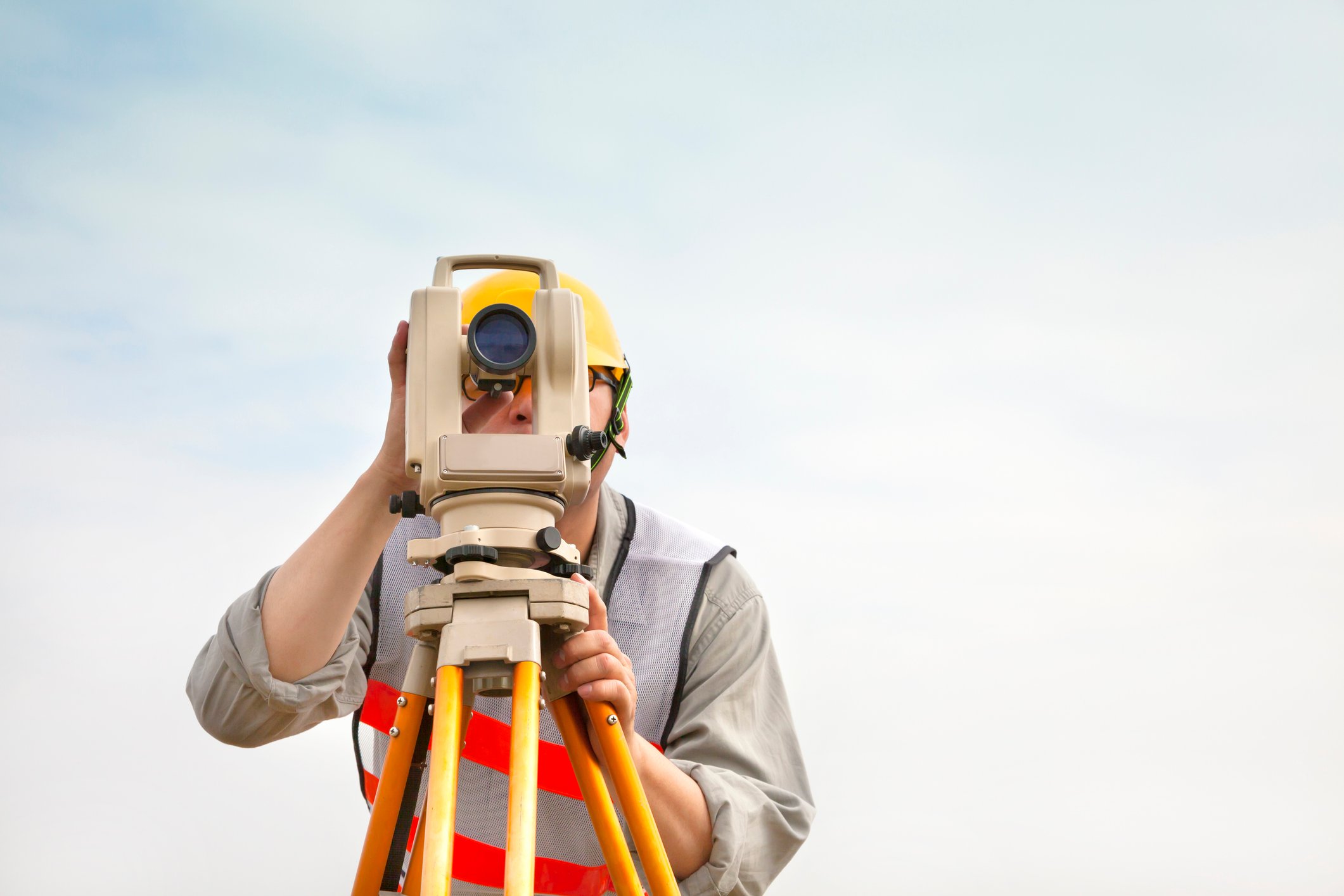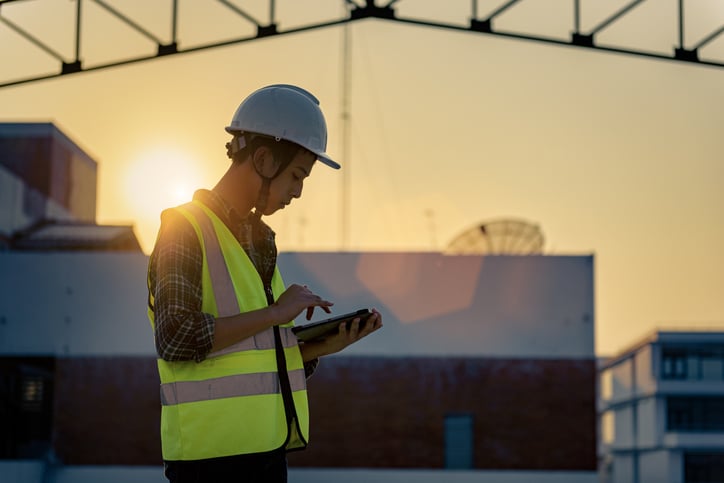
The advent of Building Information Modeling (BIM) has revolutionized construction, but the need for skilled surveyors is as strong as ever. Indeed, surveyors play a critical yet often overlooked role in the successful implementation of BIM. In this article, we will explain how the geospatial expertise of surveyors is vital to BIM and how BIM in turn can be used by surveyors to make their jobs easier and more efficient.
What Does a Surveyor Do? Land Surveyor Job Description
It’s a surveyor’s job to pinpoint exactly where and how a building will sit on a particular piece of land. They arrive at this determination by taking a series of mathematically precise geographical measurements that capture everything from the distances between landmarks to the horizontal and vertical contours of the landscape. With these measurements in hand, surveyors place markers that delineate construction boundaries and other noteworthy features that might impact a building project. It’s also the surveyor who researches historical property records and land titles, all of which can influence the future use of a property. Once all this data has been collected, surveyors are then responsible for converting it into detailed maps and reports that are understandable and usable by other stakeholders down the line.
Surveying has been vital to the envisioning and construction of human structures and settlements since the very beginnings of written history, and the tools that surveyors have used across the centuries have changed with each successive technological advancement. The ancient Romans, for instance, used a cross-shaped surveying tool called a groma to measure straight lines and create rectilinear grids. By the early 17th Century, British surveyors had begun using a long chain to measure out acres and miles. It was also around this time that the theodolite was invented, an optical instrument for measuring angles that is still in use by surveyors to this day. Global Positioning Satellite (GPS) systems are also used extensively by modern surveyors for the plotting of coordinates, while drones and LiDAR have made it easier than ever to get the lay of the land.
Another of the more recent and game-changing additions to the surveyors repertoire is something called GIS, or Geographical Information System, a digital mapping tool that enables users to visualize complex sets of data that are tied to a particular place. GIS undergirds a vast array of applications, including Google Maps, Natural Earth Data, and the property records database hosted by your local county or municipality. It’s highly likely that it was a surveyor who provided the measurements and captured the data that most GIS platforms are built upon. By the same turn, GIS is an invaluable resource that surveyors can use to supplement and enhance their work during the surveying process.
However, the latest technological advancement to make ripples in the world of surveyors–and construction in general–is a little something called BIM.
What Is BIM?
BIM, or Building Information Modeling, is a software-based technology that allows users to create data-rich 3D simulations of a building project. This “multi-dimensional” design tool enables teams to imagine and explore a wide range of possibilities for what a structure will look like and how it will behave once it’s finished.

You’ve probably heard of CAD, or Computer Aided Design, another 3D modeling tool that’s become indispensable to the architecture, engineering, and construction (AEC) industry. Well, BIM is the next evolutionary leap forward, the CT scan to CAD’s x-ray, if you will. Instead of producing a static geometrical image of a structure, BIM software is capable of generating an immersive virtual environment that can be manipulated and explored from any angle, be it a bird’s-eye view of a building’s exterior or a POV roving through its interior rooms and corridors. Even a building’s internal systems and structural materials are incorporated into the simulation, each element being responsive to minute adjustments as the users see fit.
The explosion of BIM in recent years has resulted in the opening up of a whole new career field in the world of construction: The BIM specialist, an umbrella term that covers an ever-widening branch of jobs related to the creation, analysis, and management of BIM simulations. BIM specialists combine computational knowledge with a solid understanding of design and construction principles, making them valuable assets to any project that they work on.
But a BIM model is only as valuable as the accuracy and precision of the data it’s based upon. In the context of construction, the most accurate datasets are the ones that most tightly conform with the real-world conditions that a building will exist within. This is where the surveyor comes back into the picture.
The Role of the Surveyor in BIM
In construction, it’s easy to forget that every decision made on a computer screen unfolds in real life, on an actual piece of land. With all the emphasis on digital tech these days, the just-as-important role of experts with grounded, in-depth, geospatial knowledge can sometimes go overlooked–and often with negative consequences to a project. A poorly plotted property or shoddy set of coordinates, for instance, can derail a project early on or come back to haunt it downstream. GPS, drones, LiDAR, photogrammetry, GIS, and BIM are all incredibly useful tools that make it easier than ever to visualize and capture complex geographical datasets, but they are still no substitute for the tried-and-true methodology of a skilled surveyor.

Rather than pitting new digital tools like BIM against the established discipline of surveying, we ought to instead come to a clearer understanding of how the two realms can be brought into closer alignment with one another. This alignment shouldn’t be too difficult to achieve. After all, whether it goes acknowledged or not, surveying is already instrumental to BIM through every stage of a construction project’s life cycle. Here’s how:
Planning
BIM requires accurate data in order to function properly. And it goes without saying that construction can’t happen without a clearly plotted piece of land to build on. For that matter, a valid BIM model can’t begin to be formulated in a total vacuum devoid of real-world parameters. Surveyors bridge the gap between the land and the construction process–and therefore the virtual planning process that occurs within BIM–by setting up the game board, as it were. It’s surveying data that forms the virtual foundations of a BIM model and ultimately the finished structure itself.
Design
A surveyor’s deep and precise knowledge of geography can play an enormous role in the ultimate design of the building. Some of the most iconic structures in the world, from the Louvre in Paris to the Empire State Building in New York, are defined just as much by their location within the urban landscape as they are by their unique designs. Think of how much your experience of a building is impacted by everything else around it. Is the building crowded in and obscured by neighboring structures or does it command a prominent position within a wide-open green space that allows a clear view of it from every angle? How much daylight is let in through the windows once you’re inside, and what kind of vistas do those windows look out over? The answers to these and many other questions all depend on how the building is situated within the environment. Some of the most striking structures are the ones whose designs flow with the landscape rather than pushing against it. In this way, a well-designed building won’t be simply cast adrift in a virtual void, but will be grounded in reality by incorporating and being deeply informed by the geospatial data of the environment that surrounds it.
Construction
Contrary to what you might think, the role of a surveyor doesn’t end once construction begins. Construction work has a tendency to change the baseline conditions of the land, requiring regular surveys to ensure that the building process remains on track and is able to respond to unforeseen issues that might arise. While BIM models continue to serve as valuable reference points during construction, just as the design team could benefit from a steady flow of project-level data, so too does the unique skillset of surveyors, who can perform cross-checks to safeguard against discrepancies in the virtual and actual datasets. These additional survey can then be integrated into the BIM model over time, providing an ever clearer and accurate picture of a building as it emerges.
What Are the Benefits of Using BIM for Surveying: How Can Surveyors Use BIM
The reality is that surveyors are the first link in a long chain of BIM related processes and activities. Most of this chain is forged and maintained by a wide variety of BIM specialists, but none of these can do their jobs without the reliable data provided by surveyors.

In this sense, surveyors are already BIM practitioners, whether they fully embrace it or not. They need not, however, think of this working relationship as in sole service to BIM technology. The beneficial exchange flows both ways between them, with BIM conferring a variety of boons to surveyors as well. Here are some of the ways that surveyors can make BIM work for them:
- Increased collaboration: The definition of BIM has as much to do with the highly collaborative process that it promotes as it does with the variety of software applications that make up the Building Information Modeling ecosystem. With BIM, construction teams are able to bridge gaps and open up channels of communication between departments that are all too often siloed off from one another. Surveyors who have a firm grasp of BIM and the specific inputs that make it work are better equipped to take advantage of this dynamic and collaborate more closely with the architects, engineers, and construction managers connected to a project.
- Efficient visualization of data: BIM can also help surveyors perform their jobs with greater ease, efficiency, and accuracy. There’s a reason that BIM is now the design tool of choice for a growing number of construction firms. Its visualization capabilities are unmatched, making it one of the most effective and easily understood delivery systems of complex data. Similar to how GIS opened up a whole new frontier of geospatial awareness, BIM provides a virtual space within which surveyors can house, integrate, and cross-reference their data to create a more cohesive and shared understanding of construction projects.
Bottom Line
At the end of the day, the idea that construction relies on accurate surveying isn’t anything new. What is new is the insertion of BIM into the workflow that leads from neatly surveyed plots of land to structures assembled on the spot one brick and steel beam at a time. Surveying has survived many technological advances down the ages, and will likely continue to do so well beyond whatever innovation comes after BIM. Nevertheless, as construction makes the shift (albeit a slow one) to the digital realm, more and more building projects will be conceived and designed within BIM for the foreseeable future. This means that there is a growing need for this new technology to be integrated into the ancient discipline of surveying. If simulated structures are to perform well in the real world, they must be built upon the precise measurements provided by surveyors.
New tools like LiDAR can expedite and streamline the process of capturing these measurements, and it may be tempting to think that surveying is now a point-and-click enterprise that anyone with the right gadgetry can perform. Yet you’d be mistaken to rely solely on new technology as a wholesale replacement for surveying. Just like you wouldn’t want an unskilled amateur to build your home, it takes a professional with deep geospatial knowledge and systems expertise to correctly survey a piece of property that an entire construction project will unfold on. Advanced technologies like BIM should therefore be more greatly influenced by and put in the hands of surveyors, who can use them to more deeply collaborate with other stakeholders and improve their established techniques.